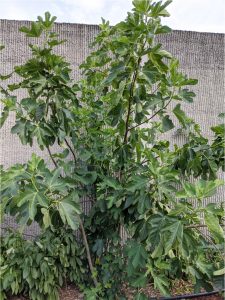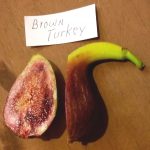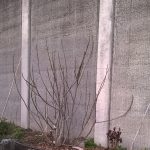Figgly Wiggly – ficus carica, a plant in the Mulberry family
August 17, 2020
Here in the Northwest only certain fig varieties will produce a large quantity of ripe fruit in our short, relatively cool summers. At Freeway Estates we have two of the most appropriate varieties: Desert King and Brown Turkey. This year, the three mature Desert Kings produced a large crop. The two Brown Turkeys are younger trees and one of them has just begun producing. It was fun to be able to compare the flavor differences.
The best way to maximize fruit production in our climate is to grow a multi-stemmed bush. The key to good fig production is understanding when and where the fruit grows. In hot climates figs can produce two crops per year – the breba (Latin- bifera – twice bearing) crop and the main crop. The breba crop grows on second year wood while the main crop grows on the current year’s new growth. In hot climates growers prune for maximum production of new wood, to get a large main crop. But in the Northwest the main crop does not have time to ripen so we prune to get a large breba crop.
If you never prune a fig, the branches containing the breba crop will be further and further away from the main trunk(s), to the point where they are nearly impossible for humans to harvest. One experienced Seattle fig grower refers to these as extremely tall bird feeders. On the other hand, if you give the tree a “hair cut”, taking off most of the new growth each year, you’ll never get ripe figs. I see this often enough and am tempted to leave my card.
We prune in March or April, just before the trees break dormancy. Remember, the breba crop grows on second year wood – the branches that were new growth the previous year.
by appointment
please email
freewayestatescommunityorchard@gmail.com
During spring pruning, it is easy to see where the previous summer’s growth starts. Looking very closely you can see the embryonic breba figs as tiny buds all along that new growth. The goal is to leave a good amount of that growth, to give us figs in the summer, while also planning for new growth that will give us figs next year. To encourage new growth we make heading cuts on some of the older branches. We also shape the tree by removing branches that are: growing in undesired directions, clogging up the the center of the “bush”, or, are dead or damaged.
I’m still learning! I thought I had pruned quite well this spring (see before and after photos) but I  did not anticipate the enormous amount of new growth our wet spring generated. Some branches grew three feet and the trees became an unruly mess (photo). We could barely find the ripening figs under all those leaves. A couple of raccoons found them easy enough, helping themselves to some overripe figs and breaking several branches in the process. Pruning next spring will be an interesting challenge. FECO will plan to offer some type of workshop.
did not anticipate the enormous amount of new growth our wet spring generated. Some branches grew three feet and the trees became an unruly mess (photo). We could barely find the ripening figs under all those leaves. A couple of raccoons found them easy enough, helping themselves to some overripe figs and breaking several branches in the process. Pruning next spring will be an interesting challenge. FECO will plan to offer some type of workshop.
Two good videos on pruning for the breba crop. Slightly different approaches in each.
https://www.youtube.com/watch?v=glFQINjnKCk
https://www.youtube.com/watch?v=RB0D_tuKgtQ
Nancy Helm




Excellent information and thanks keep updating.